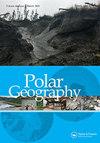Decadal scale patterns of shoreline variability in Paulatuk, N.W.T, Canada
IF 1.6
Q3 GEOGRAPHY, PHYSICAL
引用次数: 6
Abstract
ABSTRACT Dynamic changes in shoreline position as a result of natural processes and the effects of climate variability increase the susceptibility of Arctic communities that reside along the coastal zone. The application of new geospatial approaches is critical to providing updated measurements of shoreline change, necessary for sustainable coastal management strategies. This research is an integration of geographic data demarcating shoreline position and its analysis to detect change using an updated modeling application – Analyzing Moving Boundaries Using R (AMBUR). Rates-of-change were evaluated over three time periods: long-term (1984–2016); and two short-term eras (1995–2005; 2006–2016). The short-term periods were specifically chosen to assess the influence of changing sea-ice regimes, increased storm intensity, and elevated air and sea-surface temperatures. Results indicate a significant alongshore increase in the rates of erosion and the spatial extent of land loss across both segments of the study area over the short-term. Mean annual rates of change increased over the most recent period (2006–2016) along the eastern segment (−0.34 m/yr) of the study area, while the western shoreline retreated at a rate of −0.24 m/yr over the same interval. These are the highest erosion rates over any time period examined in this study. As air and ocean temperature increases continue to facilitate sea ice reduction and increased permafrost thawing, shoreline erosion may be exacerbated along the Paulatuk coastline in the coming years.加拿大保拉图克海岸变化的年代际尺度格局
由于自然过程和气候变率的影响,海岸线位置的动态变化增加了居住在海岸带的北极群落的易感性。新的地理空间方法的应用对于提供海岸线变化的最新测量至关重要,这是可持续沿海管理战略所必需的。本研究将地理数据划分海岸线位置,并使用更新的建模应用程序-使用R (AMBUR)分析移动边界来检测变化。在三个时间段内评估了变化率:长期(1984-2016);还有两个短期时期(1995-2005;2006 - 2016)。具体选择短期是为了评估海冰状况变化、风暴强度增加以及空气和海面温度升高的影响。结果表明,在短期内,研究区域的两个部分的侵蚀率和土地流失的空间范围都显着增加。在最近一段时间(2006-2016年),研究区东部岸线的年平均变化率增加(- 0.34 m/yr),而西部岸线在同一时间间隔内以- 0.24 m/yr的速度退缩。这是本研究中所检测的任何时期的最高侵蚀率。随着空气和海洋温度的升高继续促进海冰减少和永久冻土融化的增加,未来几年保拉图克海岸线的海岸线侵蚀可能会加剧。
本文章由计算机程序翻译,如有差异,请以英文原文为准。
求助全文
约1分钟内获得全文
求助全文
来源期刊

Polar Geography
GEOGRAPHY, PHYSICAL-
CiteScore
5.30
自引率
0.00%
发文量
13
期刊介绍:
Polar Geographyis a quarterly publication that offers a venue for scholarly research on the physical and human aspects of the Polar Regions. The journal seeks to address the component interplay of the natural systems, the complex historical, political, economic, cultural, diplomatic, and security issues, and the interchange amongst them. As such, the journal welcomes comparative approaches, critical scholarship, and alternative and disparate perspectives from around the globe. The journal offers scientists a venue for publishing longer papers such as might result from distillation of a thesis, or review papers that place in global context results from coordinated national and international efforts currently underway in both Polar Regions.
 求助内容:
求助内容: 应助结果提醒方式:
应助结果提醒方式:


